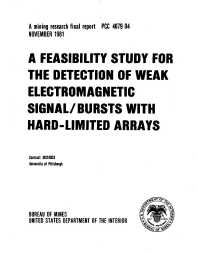Mining Publication: A Feasibility Study for the Detection of Weak Electromagnetic Signal/ Bursts With Hard-Limited Arrays
Original creation date: November 1981
A prototype detector using electromagnetic signals for finding trapped miners has previously been built and tested. The signals are generated from transmitters carried on the miner's belt and powered by his head lamp battery and the receiver is a human listener. This system has been found to be very efficient for the detection and location of trapped miners in most existing mines. However, for very deep mines, they are not adequate. Unfortunately, the signals employed, while ideally suited for a human listener, is not useable for coherent detection schemes. The objective of this report was to investigate the use of a noncoherent detector based on the polarity-coincidence statistic. Two channel, polarity-coincidence and polarity-difference, statistics were analyzed. The signal, common to both channels, consists of sinusoidal bursts where the exact frequency of the signal is nearly known, but other parameters such as amplitude, phase, and pulse starting time are unknown. The noise inputs are dependent, narrow band, Markov processes. It is shown that the performance depends not only on the signal uncertainties, but on the precise shape of the cross-correlation functions between the noise inputs. By using two polarity-difference statistics in addition to the polarity-coincidence statistic, it is shown that the decrease in performance, as well as the cost of hard limiting due to correlated inputs, can be made small.
Authors: M Kanefsky, AK Rajput
Contract/MOA Report - November 1981
NIOSHTIC2 Number: 10003948
University of Pittsburgh. U.S. Bureau of Mines Contract No. J0318033. NTIS No. PB/84-188846, 1981 Nov; :1-135
See Also
- Analytical Investigations of Electromagnetic Location Schemes Relevant to Mine Rescue: Part I - Executive Summary; Part II - Collected Reprints - Analytical Investigations of Electromagnetic Location Schemes Relevant to Mine Rescue
- Detection of Trapped Miner Electromagnetic Signals Above Coal Mines
- Development of a Phase Difference of Arrival Technique for Location of Trapped Miners
- Development of a Seismic System for Locating Trapped Miners
- Elastic and Shear Moduli of Coal Measure Rocks Derived from Basic Well Logs Using Fractal Statistics and Radial Basis Functions
- Electromagnetic Noise in Itmann Mine
- Mine Rescue Training Facility Inventory - Compendium of Ideas to Improve US Coal Mine Rescue Training
- Passive Fiber Optic System for Locating, Tracking, and Communicating with Personnel in Coal Mines
- Refuge Alternatives in Underground Coal Mines
- Refuge Chamber Deployment and Occupancy Status During Mine Emergency Situations
- Page last reviewed: 10/1/2012
- Page last updated: 9/21/2012
- Content source: National Institute for Occupational Safety and Health, Mining Program


 ShareCompartir
ShareCompartir
